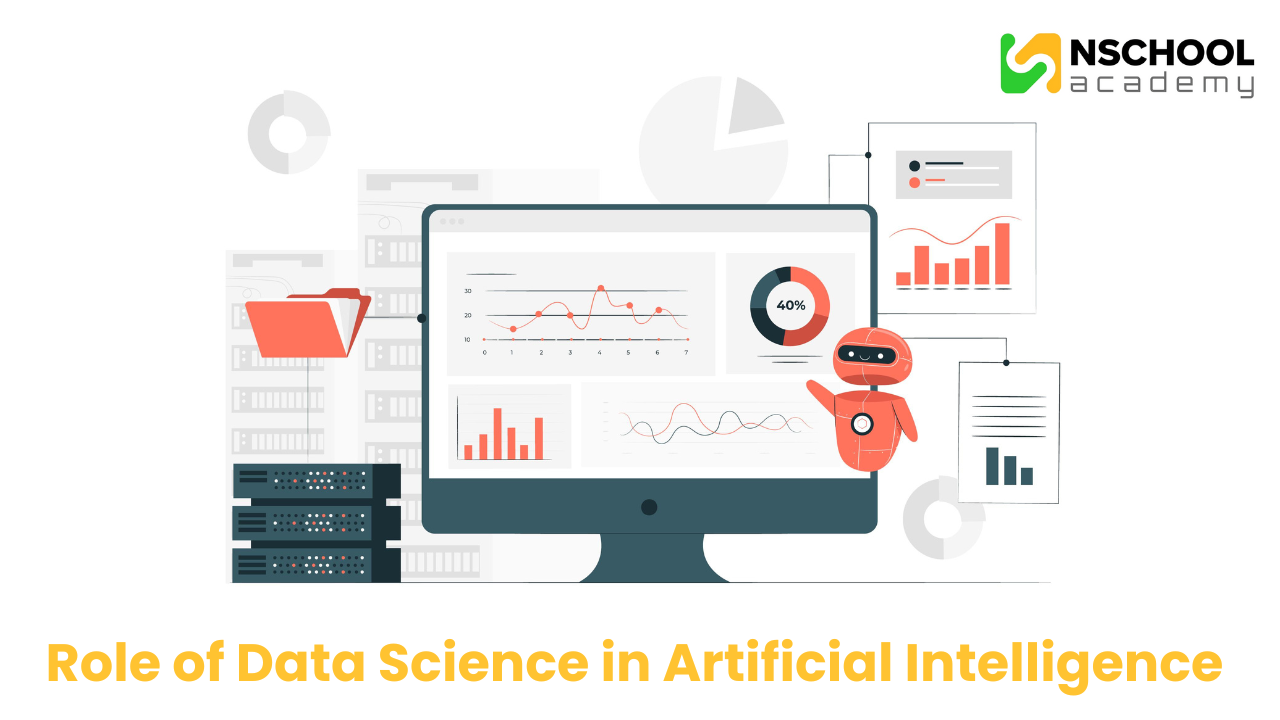The Role of Data Science in Artificial Intelligence
- May 23, 2025
- nschool
- 0

The Role of Data Science in Artificial Intelligence
In today’s digital world, two of the most powerful forces driving innovation are Data Science and Artificial Intelligence (AI). While distinct, these fields are tightly intertwined, with data science providing the essential foundation upon which AI operates. As organizations increasingly turn to intelligent systems to enhance user-friendliness, decision-making, automate operations, and personalize customer experiences, The synergy between data science and AI becomes more vital than ever.
This blog explores how data science underpins the functionality and effectiveness of AI, from model training to real-world deployment, and there are many opportunities in this field, and you have better career growth in the industry.
What Is Data Science in Artificial Intelligence?
At its core, data science is about transforming raw data into meaningful and actionable insights. It encompasses the entire lifecycle of data – collection, cleaning, transformation, analysis, visualization, and interpretation. A data scientist leverages statistical methods, coding abilities, and subject matter knowledge to identify trends and support informed decision-making.
Key components of data science include:
- Data Collection: Gathering data from various sources such as sensors, user interactions, surveys, or external databases.
- Data Cleaning: Removing inaccuracies, filling in missing values, and ensuring data consistency.
- Exploratory Data Analysis (EDA): Visualizing data distributions and identifying trends or anomalies.
- Predictive Modeling: Applying algorithms to forecast results or categorize data.
- Reporting: Presenting insights via dashboards or reports for stakeholders.
Understanding Artificial Intelligence
Artificial intelligence is the field of creating systems that can perform tasks typically requiring human intelligence. These tasks include speech recognition, decision-making, understanding language, and image identification.
Data science in artificial intelligence can be broken down into subfields:
- Machine Learning (ML): Systems learn from data to make predictions without being explicitly programmed.
- Deep Learning: A subset of ML using neural networks to analyze large volumes of unstructured data like images or audio.
- Natural Language Processing (NLP): Enables machines to understand, process, and interact using human language.
- Computer Vision: Enables machines to process and make sense of visual data to inform decisions.
Popular AI applications include autonomous vehicles, fraud detection systems, chatbots, language translation tools, and virtual assistants.
How Data Science Powers AI
AI systems’ effectiveness depends heavily on the quality of the data they are trained with and this is precisely where data science plays a crucial role. Data science provides the structured framework, techniques, and infrastructure needed to build, evaluate, and refine AI models.
- Data Preparation
Before training an AI model, data scientists gather relevant data, clean it, and transform it into a usable format. Poor-quality data leads to poor predictions, making this step crucial. - Feature Engineering
Not all raw data is directly useful. Data scientists extract features—specific variables that are most relevant for model training. For instance, in a housing price prediction model, features might include location, square footage, and age of the house. - Model Selection and Training
Data science provides the tools to train models using different algorithms (e.g., decision trees, support vector machines, neural networks). Data scientists test multiple models and tune hyperparameters to find the best performer. - Model Evaluation
Once trained, models must be validated using techniques like cross-validation, confusion matrices, precision-recall scores, and ROC curves. This ensures the AI performs accurately and reliably on real-world data. - Deployment and Monitoring
Data science doesn’t end with a deployed model. Continuous monitoring ensures models adapt to changing data patterns and remain effective over time.
Practical Applications of AI Powered by Data Science
The collaboration between AI and data science is transforming nearly every industry. Here are some practical examples from the real world:
- Healthcare
- AI systems diagnose diseases, predict patient risks, and personalize treatment plans. Data science helps clean and standardize patient data, ensuring AI models provide accurate diagnostics and recommendation
2.E-commerce
- Major retailers such as Amazon utilize AI-driven recommendation engines to offer personalized product suggestions. These models rely on user behavior data—what you search, click, and buy—cleaned and structured by data science techniques.
3.Finance
- Banks use AI for fraud detection, credit scoring, and algorithmic trading. Data scientists develop and test models using historical transaction data, continuously updating them to catch evolving fraud tactics.
4. Transportation
- From optimizing delivery routes to powering autonomous vehicles, data science fuels AI algorithms that analyze traffic patterns, sensor data, and geospatial information.
5.Entertainment
- Services like Netflix and Spotify leverage AI to customize content recommendations to individual user preferences. Data science processes viewing/listening histories to help the AI understand individual preferences.
Challenges in Integrating Data Science with Artificial Intelligence
Even though data science and AI have great potential, combining them still comes with some challenges.
- Data Quality and Volume
AI models require vast amounts of clean, labeled data. Poor data can result in misleading predictions or model failures.
- Bias and Ethics
AI can pick up biases from the data it learns from, which can cause unfair or unequal results. For instance, a hiring tool trained on biased past data might prefer one group of people over another
3. Infrastructure and Scalability
Processing and storing large datasets demands robust infrastructure. Organizations must invest in cloud computing, databases, and data pipelines.
- Interpretability
AI models, particularly deep learning models, often work like black boxes, making it hard to understand how they make decisions. Data scientists play a critical role in making these models interpretable and transparent for stakeholders.
The Future of Data Science in AI
As both fields grow, they will rely on each other even more.Here’s a glimpse of what the future may bring:
- AutoML: Automated machine learning platforms will make it easier for non-experts to develop AI models, guided by principles from data science. Compared to other platforms, it’s a very easy learning platform.
- AI Ops: Data science will play a major role in using AI to automate IT operations and system monitoring.
- Edge AI: With growing demand for real-time decision-making, data science will help optimize models for edge devices like mobile phones and IoT sensors.
- Personalized AI: AI will become more personalized, understanding individual behavior better—thanks to refined data science models and techniques.
The demand for professionals who can bridge the gap between data science and AI is rapidly growing. Roles like machine learning engineers, data engineers, and AI researchers are in high demand.
Conclusion
Data science is the backbone of artificial intelligence. It handles everything from collecting and cleaning data to building and testing models, helping AI to learn and get better. Without good data, AI can’t work—and data science makes sure that data is clear, useful, and reliable.
If you want to build smart systems or drive innovation in any field, understanding data science isn’t just helpful—it’s essential.
Start learning data science now, and you’ll be ready to unlock the full power of AI in the future.

